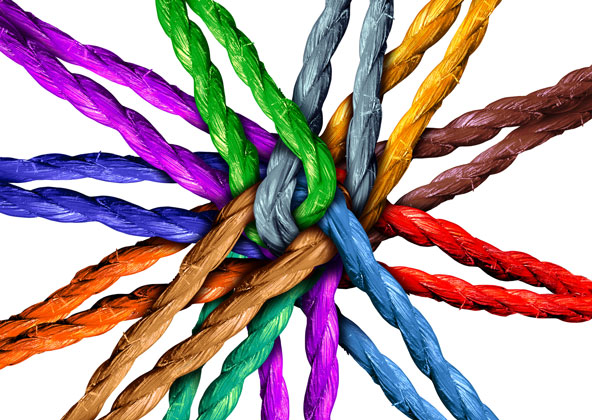I've spent a lot of time in the footwork and weeds of collective impact organizations. Some have been community councils that become ersatz backbone organizations, others were established as backbone organizations, and some were loose collectives of partner organizations just trying to make it work.
All of them were primarily uninterested in the model of collective impact or the terminology and instead bought entirely into the idea of the promised impact. Some, surprisingly, expected that the collective impact model would bring about systems change and, thus impact, so much faster than any other method. This was actually an astonishing thought; the collective impact model is such a sophisticated and difficult method to adopt, it's hard to imagine anyone thinking it would actually accelerate impact.
The problem, it seems, is in a basic misunderstanding of what the collective impact model actually is.
Collective Impact Does Not Always Equal Systems Change
My friends at the National Fund for Workforce Solutions offer a great definition and one that I'll rely on here:
We use it as shorthand to describe strategies that are informed by a systems thinking mindset. Systems change is about intentionally seeing and then changing the dynamics around a particular problem in order to solve it. These strategies focus on complex problems made up of multiple interrelated problems and stakeholders.
Right away, we can see why systems' change work might beg for a collective impact approach. It involves a large project with a diverse set of stakeholders. It would behoove any network looking for systems change to consider using the the collective impact model to govern a systems change initiative.
But collective impact is not synonymous with systems change. In fact, (in)famously, John Kania and Mark Kramer, set forth five conditions which, they theorized, explained why one network in Cincinnati was able to achieve progress on a decades' long racialized achievement gap (2011). Strive, now an industry leader in operationalizing a collective impact model for social change or reform known as StriveTogether, and a handful of crucial and pivotal community leaders realized that they could leverage the power of intentionality and resources by agreeing to tackle the achievement gap by agreeing on the definition of the problem, finding consensus on an agenda to solve this problem among stakeholders, sharing and using data to inform strategy and continuous improvement, opening lines of communication between historically siloed stakeholders, etc. Anyone who has heard the term "collective impact" can probably rattle off the others of the five conditions Kania and Kramer identified in their 2011 SSIR article now part of the lore and mystique of the cult of collective impact.
In the case fo Strive, a system change was realized in the identification and amelioration of the institutional and cultural conditions paving the way for a racialized achievement gap in Cincinnati schools. Honestly, slow clap for them. Their results are incredibly impressive, even 10+ years later. But attend any conference at which they speak (all of them, including their own) and they'll tell you the road was rough, their results wasn't perfect, the relationship piece is by far the hardest, and their timeline for "wins" was very long. Collective impact is a method to change institutions by changing their culture. Collective impact formalizes and enshrines a highly collaborative, highly trusting relationship among stakeholders who are often in competition with each other. As Andrew Shepard in The American President says about a similarly sophisticated and challenging concept (Democracy), "You gotta want it bad."
Therefore, collective impact is one way to achieve systems change but it is not the change itself and it is not easy.
Collective impact has to be a model to achieve social change and not an end in itself.
One of the organizations I've worked with recently has been in the midst of an identity crisis since its inception many years ago. Hampered by infighting, nepotism, community politics, and various cults of personality, it continues to suffer one struggle after the next, never quite landing on anything either regarding strategy or, frankly, even agreeing on outcomes. Why?
My theory is that they've swapped the method (collective impact) and the systems change (improving a devastating, decades-long racialized achievement gap in their school). Instead of just focusing on the changes they want to see in the system and making them without worrying about garnering a consensus on agenda or sharing data, they burdened themselves by also taking on collective impact which became an end unto itself because culturally they're not ready for that level of collaboration. When that happened, it created two distinct ends: create a culture conducive to implementing collective impact AND also solving the racialized achievement gap. The choice of collective impact as the method, in hindsight, was too ambitious for their culture to bear. Meanwhile, the racilaized achievement gap grows.
The devil really is in the details.
Very often, what I would hear at this organization was that my approach was too academic; I was too concerned with terms and models. "Just get to work," I would hear very often.
The problem with that is it never gives anyone the chance to sort out what's happening. Had we evaluated and re-thought the use of collective impact as the theory of social change, chances are they'd be further along on their intended goal of improving that achievement gap. Instead, they continue to assume they're far beyond the basics of establishing a shared agenda, sharing data, and communicating honestly when they're not ready to undertake any of the actions required to implement a collective impact model.
My advice to networks everywhere: rigorously self-reflect. If you're not ready culturally to drop ego and be receptive to true and honest collaboration, then don't worry about collective impact. Shoot for systems change and make the changes you yourselves have the power to make.
Systems change does not require collective impact. But collective impact can truly derail any systems change if the players aren't ready to adopt it whole hog.
Sources:
Kania, John and Mark Kramer. 2011. "Collective Impact." Winter. Stanford Social Innovation Review.
https://ssir.org/articles/entry/collective_impact. Accessed 5. 13. 22.
National Fund For Workforce Solutions. "Our Change Systems Solutions." https://nationalfund.org.
Accessed 5.13.22.



Comments
Post a Comment